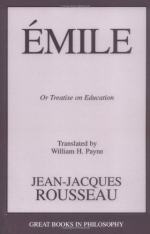In this way the closest reasoner, if he is not inventive, may find himself at a loss. What is the result? Instead of making us discover proofs, they are dictated to us; instead of teaching us to reason, our memory only is employed.
Draw accurate figures, combine them together, put them one upon another, examine their relations, and you will discover the whole of elementary geometry in passing from one observation to another, without a word of definitions, problems, or any other form of demonstration but super-position. I do not profess to teach Emile geometry; he will teach me; I shall seek for relations, he will find them, for I shall seek in such a fashion as to make him find. For instance, instead of using a pair of compasses to draw a circle, I shall draw it with a pencil at the end of bit of string attached to a pivot. After that, when I want to compare the radii one with another, Emile will laugh at me and show me that the same thread at full stretch cannot have given distances of unequal length. If I wish to measure an angle of 60 degrees I describe from the apex of the angle, not an arc, but a complete circle, for with children nothing must be taken for granted. I find that the part of the circle contained between the two lines of the angle is the sixth part of a circle. Then I describe another and larger circle from the same centre, and I find the second arc is again the sixth part of its circle. I describe a third concentric circle with a similar result, and I continue with more and more circles till Emile, shocked at my stupidity, shows me that every arc, large or small, contained by the same angle will always be the sixth part of its circle. Now we are ready to use the protractor.
To prove that two adjacent angles are equal to two right angles people describe a circle. On the contrary I would have Emile observe the fact in a circle, and then I should say, “If we took away the circle and left the straight lines, would the angles have changed their size, etc.?”
Exactness in the construction of figures is neglected; it is taken for granted and stress is laid on the proof. With us, on the other hand, there will be no question of proof. Our chief business will be to draw very straight, accurate, and even lines, a perfect square, a really round circle. To verify the exactness of a figure we will test it by each of its sensible properties, and that will give us a chance to discover fresh properties day by day. We will fold the two semi-circles along the diameter, the two halves of the square by the diagonal; he will compare our two figures to see who has got the edges to fit moat exactly, i.e., who has done it best; we should argue whether this equal division would always be possible in parallelograms, trapezes, etc. We shall sometimes try to forecast the result of an experiment, to find reasons, etc.
Geometry means to my scholar the successful use of the rule and compass; he must not confuse it with drawing, in which these instruments are not used. The rule and compass will be locked up, so that he will not get into the way of messing about with them, but we may sometimes take our figures with us when we go for a walk, and talk over what we have done, or what we mean to do.




